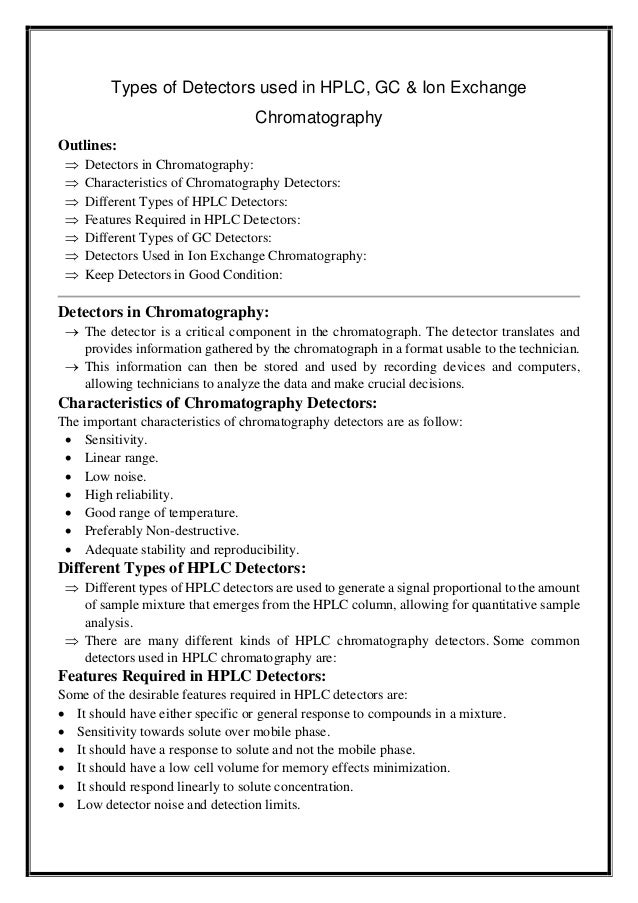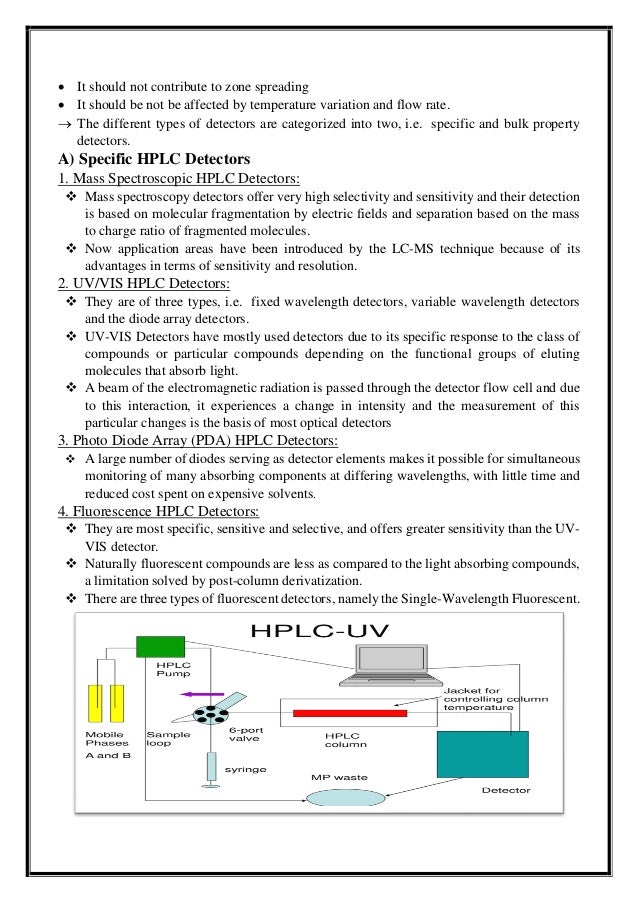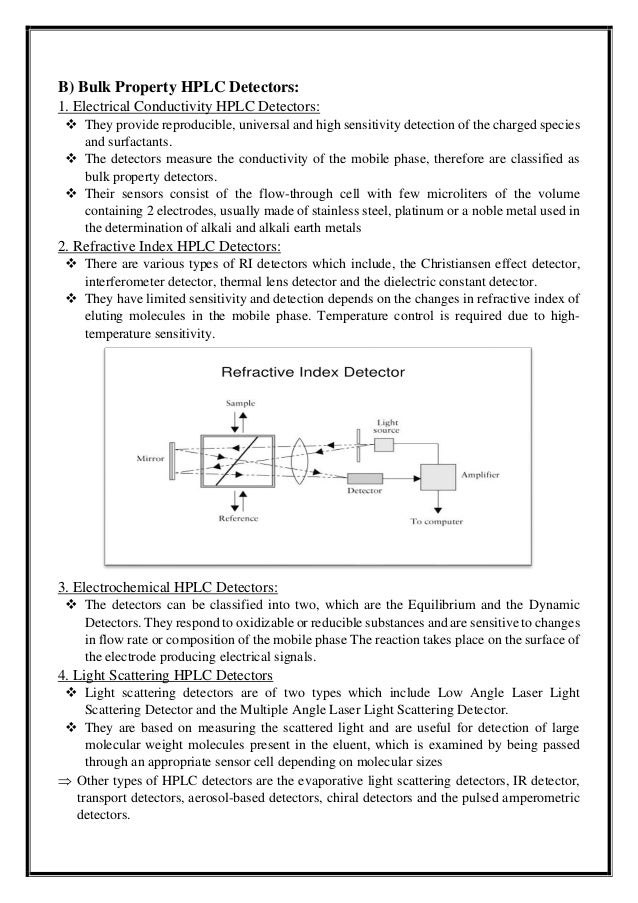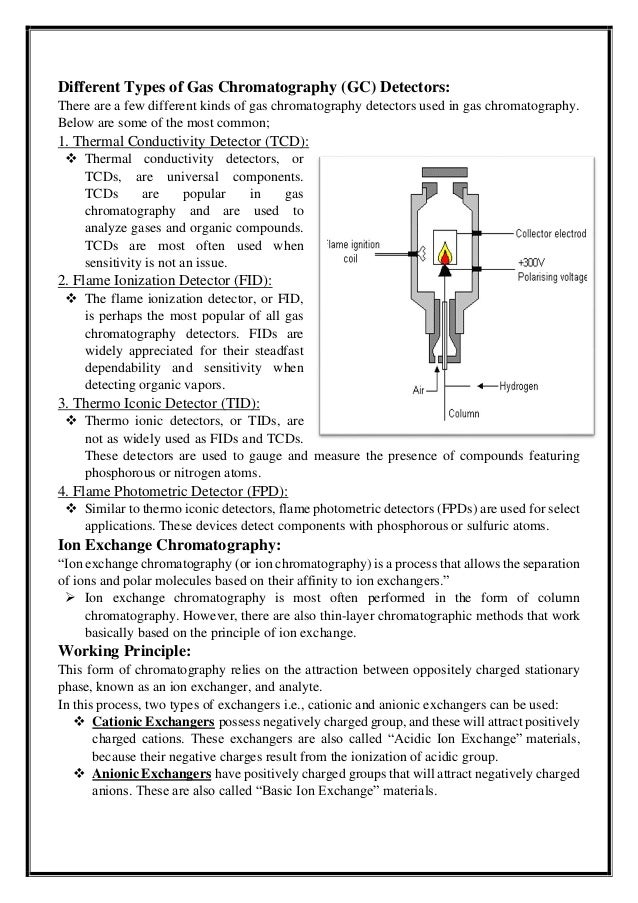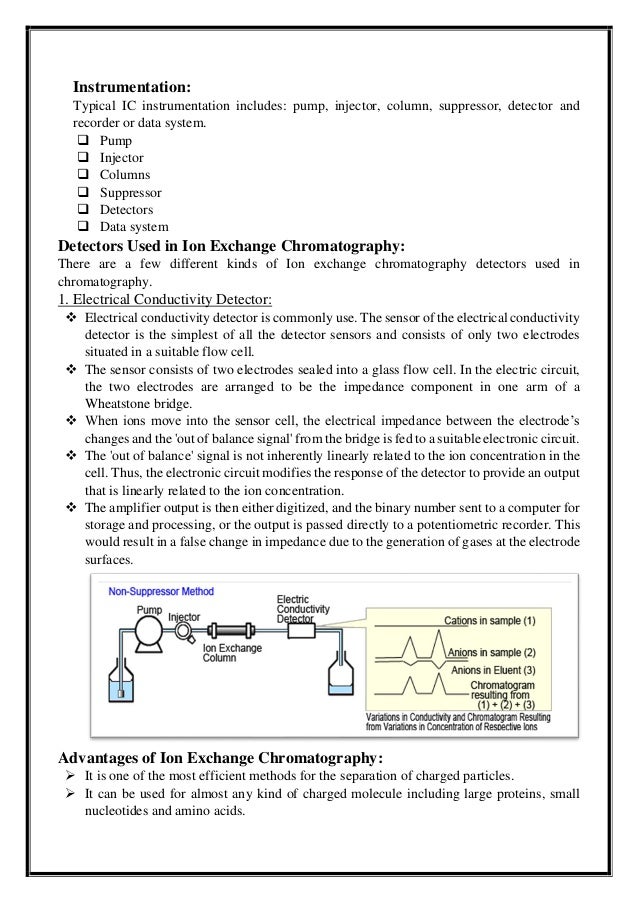Detectors used in HPLC, GC & I.E Chromatography.pdf
- 1. Types of Detectors used in HPLC, GC & Ion Exchange Chromatography Outlines: ’ā× Detectors in Chromatography: ’ā× Characteristics of Chromatography Detectors: ’ā× Different Types of HPLC Detectors: ’ā× Features Required in HPLC Detectors: ’ā× Different Types of GC Detectors: ’ā× Detectors Used in Ion Exchange Chromatography: ’ā× Keep Detectors in Good Condition: Detectors in Chromatography: ŌåÆ The detector is a critical component in the chromatograph. The detector translates and provides information gathered by the chromatograph in a format usable to the technician. ŌåÆ This information can then be stored and used by recording devices and computers, allowing technicians to analyze the data and make crucial decisions. Characteristics of Chromatography Detectors: The important characteristics of chromatography detectors are as follow: ŌĆó Sensitivity. ŌĆó Linear range. ŌĆó Low noise. ŌĆó High reliability. ŌĆó Good range of temperature. ŌĆó Preferably Non-destructive. ŌĆó Adequate stability and reproducibility. Different Types of HPLC Detectors: ’ā× Different types of HPLC detectors are used to generate a signal proportional to the amount of sample mixture that emerges from the HPLC column, allowing for quantitative sample analysis. ’ā× There are many different kinds of HPLC chromatography detectors. Some common detectors used in HPLC chromatography are: Features Required in HPLC Detectors: Some of the desirable features required in HPLC detectors are: ŌĆó It should have either specific or general response to compounds in a mixture. ŌĆó Sensitivity towards solute over mobile phase. ŌĆó It should have a response to solute and not the mobile phase. ŌĆó It should have a low cell volume for memory effects minimization. ŌĆó It should respond linearly to solute concentration. ŌĆó Low detector noise and detection limits.
- 2. ŌĆó It should not contribute to zone spreading ŌĆó It should be not be affected by temperature variation and flow rate. ŌåÆ The different types of detectors are categorized into two, i.e. specific and bulk property detectors. A) Specific HPLC Detectors 1. Mass Spectroscopic HPLC Detectors: ŌØ¢ Mass spectroscopy detectors offer very high selectivity and sensitivity and their detection is based on molecular fragmentation by electric fields and separation based on the mass to charge ratio of fragmented molecules. ŌØ¢ Now application areas have been introduced by the LC-MS technique because of its advantages in terms of sensitivity and resolution. 2. UV/VIS HPLC Detectors: ŌØ¢ They are of three types, i.e. fixed wavelength detectors, variable wavelength detectors and the diode array detectors. ŌØ¢ UV-VIS Detectors have mostly used detectors due to its specific response to the class of compounds or particular compounds depending on the functional groups of eluting molecules that absorb light. ŌØ¢ A beam of the electromagnetic radiation is passed through the detector flow cell and due to this interaction, it experiences a change in intensity and the measurement of this particular changes is the basis of most optical detectors 3. Photo Diode Array (PDA) HPLC Detectors: ŌØ¢ A large number of diodes serving as detector elements makes it possible for simultaneous monitoring of many absorbing components at differing wavelengths, with little time and reduced cost spent on expensive solvents. 4. Fluorescence HPLC Detectors: ŌØ¢ They are most specific, sensitive and selective, and offers greater sensitivity than the UV- VIS detector. ŌØ¢ Naturally fluorescent compounds are less as compared to the light absorbing compounds, a limitation solved by post-column derivatization. ŌØ¢ There are three types of fluorescent detectors, namely the Single-Wavelength Fluorescent.
- 3. B) Bulk Property HPLC Detectors: 1. Electrical Conductivity HPLC Detectors: ŌØ¢ They provide reproducible, universal and high sensitivity detection of the charged species and surfactants. ŌØ¢ The detectors measure the conductivity of the mobile phase, therefore are classified as bulk property detectors. ŌØ¢ Their sensors consist of the flow-through cell with few microliters of the volume containing 2 electrodes, usually made of stainless steel, platinum or a noble metal used in the determination of alkali and alkali earth metals 2. Refractive Index HPLC Detectors: ŌØ¢ There are various types of RI detectors which include, the Christiansen effect detector, interferometer detector, thermal lens detector and the dielectric constant detector. ŌØ¢ They have limited sensitivity and detection depends on the changes in refractive index of eluting molecules in the mobile phase. Temperature control is required due to high- temperature sensitivity. 3. Electrochemical HPLC Detectors: ŌØ¢ The detectors can be classified into two, which are the Equilibrium and the Dynamic Detectors. They respond to oxidizable or reducible substances and are sensitive to changes in flow rate or composition of the mobile phase The reaction takes place on the surface of the electrode producing electrical signals. 4. Light Scattering HPLC Detectors ŌØ¢ Light scattering detectors are of two types which include Low Angle Laser Light Scattering Detector and the Multiple Angle Laser Light Scattering Detector. ŌØ¢ They are based on measuring the scattered light and are useful for detection of large molecular weight molecules present in the eluent, which is examined by being passed through an appropriate sensor cell depending on molecular sizes ’ā× Other types of HPLC detectors are the evaporative light scattering detectors, IR detector, transport detectors, aerosol-based detectors, chiral detectors and the pulsed amperometric detectors.
- 4. Different Types of Gas Chromatography (GC) Detectors: There are a few different kinds of gas chromatography detectors used in gas chromatography. Below are some of the most common; 1. Thermal Conductivity Detector (TCD): ŌØ¢ Thermal conductivity detectors, or TCDs, are universal components. TCDs are popular in gas chromatography and are used to analyze gases and organic compounds. TCDs are most often used when sensitivity is not an issue. 2. Flame Ionization Detector (FID): ŌØ¢ The flame ionization detector, or FID, is perhaps the most popular of all gas chromatography detectors. FIDs are widely appreciated for their steadfast dependability and sensitivity when detecting organic vapors. 3. Thermo Iconic Detector (TID): ŌØ¢ Thermo ionic detectors, or TIDs, are not as widely used as FIDs and TCDs. These detectors are used to gauge and measure the presence of compounds featuring phosphorous or nitrogen atoms. 4. Flame Photometric Detector (FPD): ŌØ¢ Similar to thermo iconic detectors, flame photometric detectors (FPDs) are used for select applications. These devices detect components with phosphorous or sulfuric atoms. Ion Exchange Chromatography: ŌĆ£Ion exchange chromatography (or ion chromatography) is a process that allows the separation of ions and polar molecules based on their affinity to ion exchangers.ŌĆØ Ō×ó Ion exchange chromatography is most often performed in the form of column chromatography. However, there are also thin-layer chromatographic methods that work basically based on the principle of ion exchange. Working Principle: This form of chromatography relies on the attraction between oppositely charged stationary phase, known as an ion exchanger, and analyte. In this process, two types of exchangers i.e., cationic and anionic exchangers can be used: ŌØ¢ Cationic Exchangers possess negatively charged group, and these will attract positively charged cations. These exchangers are also called ŌĆ£Acidic Ion ExchangeŌĆØ materials, because their negative charges result from the ionization of acidic group. ŌØ¢ Anionic Exchangers have positively charged groups that will attract negatively charged anions. These are also called ŌĆ£Basic Ion ExchangeŌĆØ materials.
- 5. Instrumentation: Typical IC instrumentation includes: pump, injector, column, suppressor, detector and recorder or data system. ŌØæ Pump ŌØæ Injector ŌØæ Columns ŌØæ Suppressor ŌØæ Detectors ŌØæ Data system Detectors Used in Ion Exchange Chromatography: There are a few different kinds of Ion exchange chromatography detectors used in chromatography. 1. Electrical Conductivity Detector: ŌØ¢ Electrical conductivity detector is commonly use. The sensor of the electrical conductivity detector is the simplest of all the detector sensors and consists of only two electrodes situated in a suitable flow cell. ŌØ¢ The sensor consists of two electrodes sealed into a glass flow cell. In the electric circuit, the two electrodes are arranged to be the impedance component in one arm of a Wheatstone bridge. ŌØ¢ When ions move into the sensor cell, the electrical impedance between the electrodeŌĆÖs changes and the 'out of balance signal' from the bridge is fed to a suitable electronic circuit. ŌØ¢ The 'out of balance' signal is not inherently linearly related to the ion concentration in the cell. Thus, the electronic circuit modifies the response of the detector to provide an output that is linearly related to the ion concentration. ŌØ¢ The amplifier output is then either digitized, and the binary number sent to a computer for storage and processing, or the output is passed directly to a potentiometric recorder. This would result in a false change in impedance due to the generation of gases at the electrode surfaces. Advantages of Ion Exchange Chromatography: Ō×ó It is one of the most efficient methods for the separation of charged particles. Ō×ó It can be used for almost any kind of charged molecule including large proteins, small nucleotides and amino acids.
- 6. Ō×ó Inorganic ions also can be separated by ion-exchange chromatography. Disadvantages of Ion Exchange Chromatography: Ō×ó Only charged molecules can be separated. Ō×ó Buffer Requirement. Ō×ó This technique is only limited to separation of charged ions or polar molecules. Ō×ó It requires large volume of sample. Ō×ó Instrument is expensive and requires expensive chemicals such as buffers. Keep Detectors in Good Condition: ŌĆó ItŌĆÖs important to ensure your HPLC and gas chromatography detectors are properly maintained over time. ŌĆó To keep equipment in good shape, make sure to clean equipment thoroughly after each use and keep track of when it was lastŌĆ»serviced. Best of Luck
